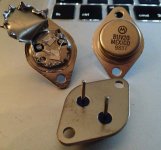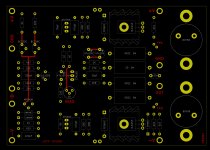I'm putting together a small group buy of NAP250 boards.
This is a true nostalgia project with considerable research done into the original circuit and device selection. I'm even deleting the silkscreen and solder-mask on the boards. (It will be a two layer board with plated-through holes and a lead-free HASL finish, so not entirely old-school).
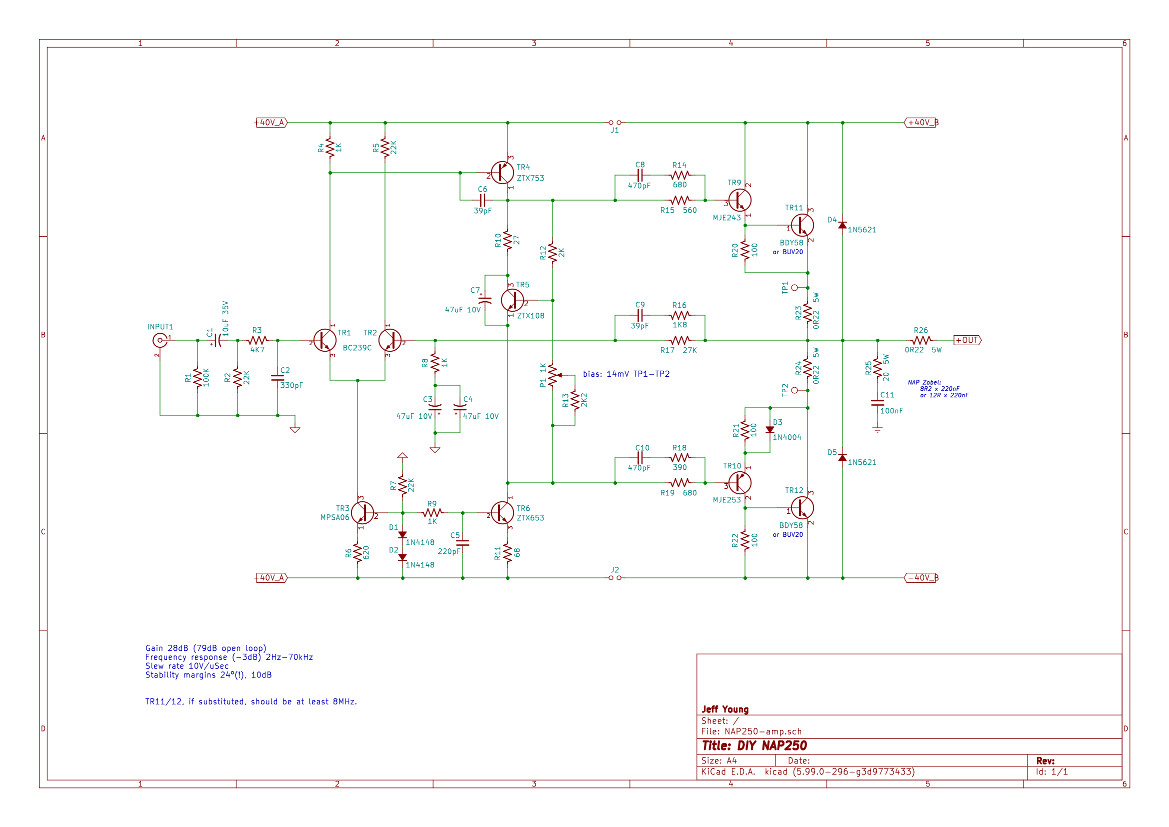
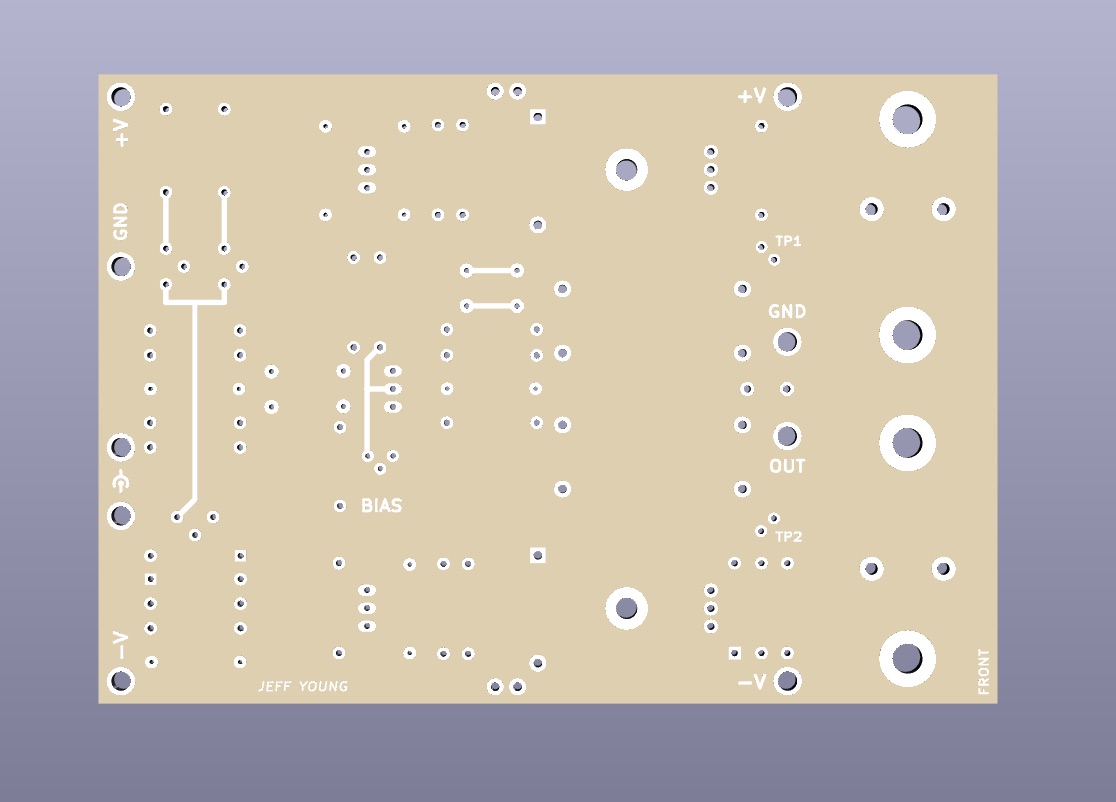
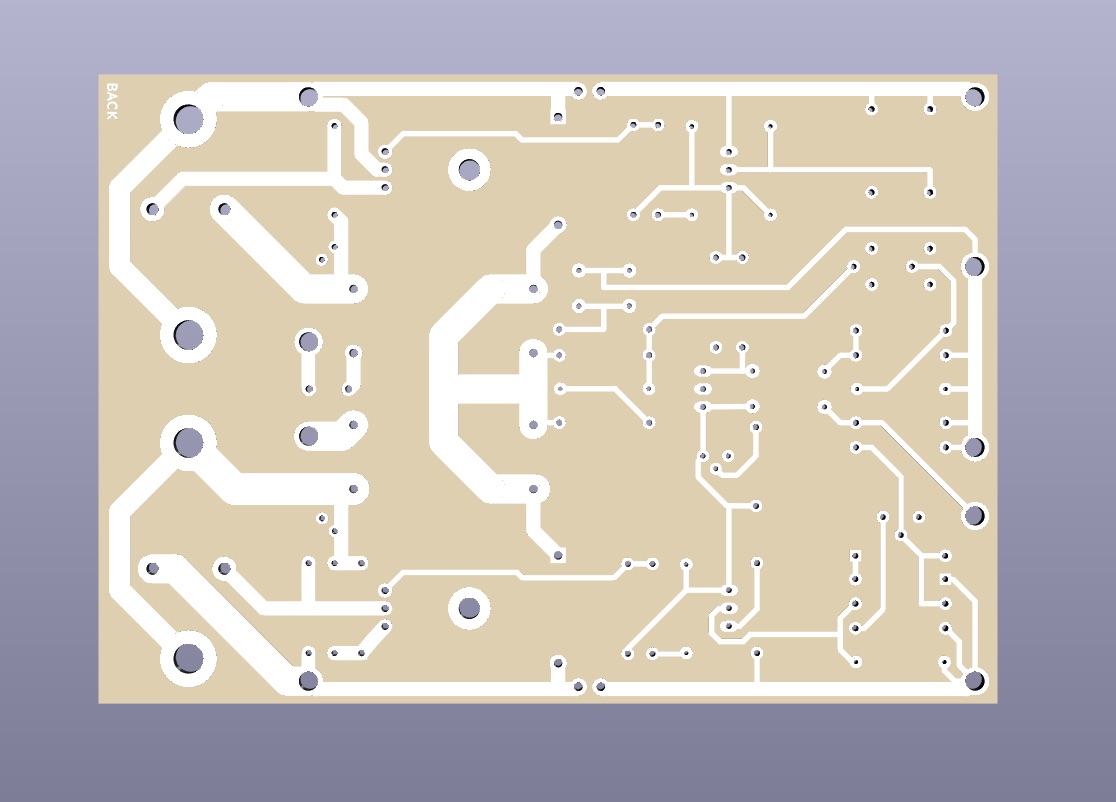
I have designs for both the original regulators (again, without SOA), and an inverted one which references the VAS to ground, greatly increasing its PSRR at high frequency.
See more here:
NAP250 clone
Please copy the last-posted list and add your own name, along with which regulators you're interested in.
Cheers,
Jeff.
This is a true nostalgia project with considerable research done into the original circuit and device selection. I'm even deleting the silkscreen and solder-mask on the boards. (It will be a two layer board with plated-through holes and a lead-free HASL finish, so not entirely old-school).
I have designs for both the original regulators (again, without SOA), and an inverted one which references the VAS to ground, greatly increasing its PSRR at high frequency.
See more here:
NAP250 clone
Please copy the last-posted list and add your own name, along with which regulators you're interested in.
Cheers,
Jeff.
Hi Jeff,
Any clues as to where to source the BC239C input transistors and either of the output TO3 metal can types you have on the schematic. Not stocked at Mouser. All the other transistors are in stock in qty at Mouser , so no problems with those.
Or, have you further alternatives, should not be too hard for the inputs TR1 and TR2. Maybe the output stage TR11 and TR12 need to be as close to original design semi's as possible.
Look forward to your thought on these devices.
Gary..
Any clues as to where to source the BC239C input transistors and either of the output TO3 metal can types you have on the schematic. Not stocked at Mouser. All the other transistors are in stock in qty at Mouser , so no problems with those.
Or, have you further alternatives, should not be too hard for the inputs TR1 and TR2. Maybe the output stage TR11 and TR12 need to be as close to original design semi's as possible.
Look forward to your thought on these devices.
Gary..
Hi Gary,
The NAP is like a treasure hunt.
I got my BC239Cs (and ZTX108s) from Langrex. (They're mostly a vintage tube supplier, but also stock some semis.)
I got NOS Siemens BDY58s from NJSemi. Ask for Ron. (FWIW, they also have Harris IRFP9240s.)
I got NOS BUV20s from 2 different sellers on eBay. Much care is required here -- the BUV20s are actively counterfeited. (And FWIW, the BDY58s were factory spec in early units, whereas the BUV20s never were.)
The most important transistors to this design are probably TR4 and TR6 (for their unusually high Cob), followed by the drivers and output devices.
A lot of folks swear by the MJ15003 for output devices, but they fly in the face of the speed JV was aiming for. You can colour me somewhat skeptical regarding them.
Cheers,
Jeff.
One of my BUV20s opened up to ensure it was what it was supposed to be inside:
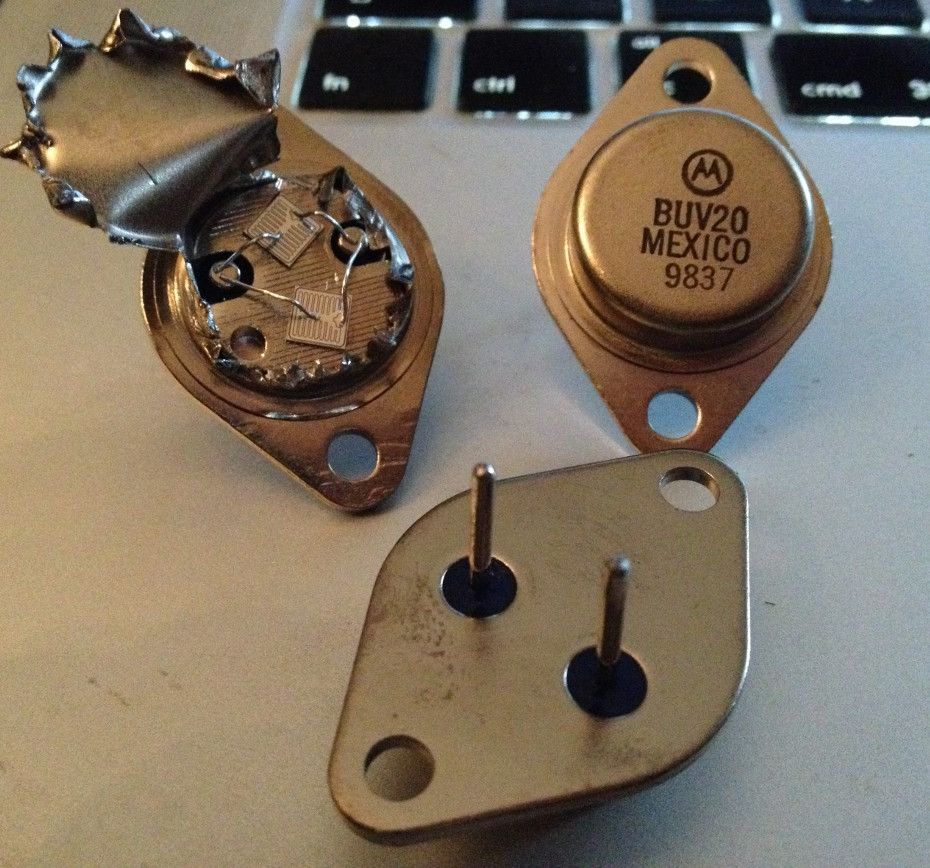
The NAP is like a treasure hunt.
I got my BC239Cs (and ZTX108s) from Langrex. (They're mostly a vintage tube supplier, but also stock some semis.)
I got NOS Siemens BDY58s from NJSemi. Ask for Ron. (FWIW, they also have Harris IRFP9240s.)
I got NOS BUV20s from 2 different sellers on eBay. Much care is required here -- the BUV20s are actively counterfeited. (And FWIW, the BDY58s were factory spec in early units, whereas the BUV20s never were.)
The most important transistors to this design are probably TR4 and TR6 (for their unusually high Cob), followed by the drivers and output devices.
A lot of folks swear by the MJ15003 for output devices, but they fly in the face of the speed JV was aiming for. You can colour me somewhat skeptical regarding them.
Cheers,
Jeff.
One of my BUV20s opened up to ensure it was what it was supposed to be inside:
Attachments
How do you connect the two grounds GND_A and GND_B with respect to the input signal ground and the chassis ground?
Do you connect the GND_A at the mid tap of the transformer?
Do you connect the GND_B at the input signal ground or at the speaker output ground?
Do you float the input signal ground from the output speaker ground to isolate the high currents from the low level signal currents?
Do you connect the GND_A at the mid tap of the transformer?
Do you connect the GND_B at the input signal ground or at the speaker output ground?
Do you float the input signal ground from the output speaker ground to isolate the high currents from the low level signal currents?
Both GND_A and GND_B go back to the star ground (as do the two GNDs on the amp board -- one of which is connected to the input signal ground).
The star *should* be a short 'T' from the wire between the two smoothing caps, but Naim originally used the negative speaker output, and then the wire between the caps without a 'T'. The latter is probably sufficient (and is what I plan on using), but I wouldn't recommend the former.
The star *should* be a short 'T' from the wire between the two smoothing caps, but Naim originally used the negative speaker output, and then the wire between the caps without a 'T'. The latter is probably sufficient (and is what I plan on using), but I wouldn't recommend the former.
JeffYoung: 6 amp, 2 original_reg, 4 inverted_reg
lohk: 2 amp, 2 inverted_reg
john.luckins: 2 amp, 2 inverted_reg
avtech23: 2 amp, 2 inverted_reg
ultima legion: 2 amp (original_reg, inverted_reg, or both?)
jean michael: 4 amp, 4 inverted_reg
gary s: 2 amp, 2 inverted_reg
Quantensprung: 4 amp, 2 original_reg, 2 inverted_reg
lohk: 2 amp, 2 inverted_reg
john.luckins: 2 amp, 2 inverted_reg
avtech23: 2 amp, 2 inverted_reg
ultima legion: 2 amp (original_reg, inverted_reg, or both?)
jean michael: 4 amp, 4 inverted_reg
gary s: 2 amp, 2 inverted_reg
Quantensprung: 4 amp, 2 original_reg, 2 inverted_reg
JeffYoung: 6 amp, 2 original_reg, 4 inverted_reg
lohk: 2 amp, 2 inverted_reg
john.luckins: 2 amp, 2 inverted_reg
avtech23: 2 amp, 2 inverted_reg
ultima legion: 2 amp (original_reg, inverted_reg, or both?)
jean michael: 4 amp, 4 inverted_reg
gary s: 2 amp, 2 inverted_reg
Quantensprung: 4 amp, 2 original_reg, 2 inverted_reg
Skunark: 4 amp, 2 original_reg, 2 inverted_reg
lohk: 2 amp, 2 inverted_reg
john.luckins: 2 amp, 2 inverted_reg
avtech23: 2 amp, 2 inverted_reg
ultima legion: 2 amp (original_reg, inverted_reg, or both?)
jean michael: 4 amp, 4 inverted_reg
gary s: 2 amp, 2 inverted_reg
Quantensprung: 4 amp, 2 original_reg, 2 inverted_reg
Skunark: 4 amp, 2 original_reg, 2 inverted_reg
Hi Jeff,
Looking at chassis options, can you give me the dimensions of the amp and reg pcb's?
Also I assume on the mains side of the transformer Naim just had an IEC input socket, mains fuse, mains switch into the transformer primary.
What VA rating was the transformer, and what were the voltages on the sec windings?
What did they use for a bridge rectifier and what did they have for the main PSU caps?
Sorry for the questions if you have covered this elsewhere, but could not find it.
The other question is did they have a separate regulator pcb for each channel - hence the need for 2 off for a stereo amp.
Regards,
Gary..
Looking at chassis options, can you give me the dimensions of the amp and reg pcb's?
Also I assume on the mains side of the transformer Naim just had an IEC input socket, mains fuse, mains switch into the transformer primary.
What VA rating was the transformer, and what were the voltages on the sec windings?
What did they use for a bridge rectifier and what did they have for the main PSU caps?
Sorry for the questions if you have covered this elsewhere, but could not find it.
The other question is did they have a separate regulator pcb for each channel - hence the need for 2 off for a stereo amp.
Regards,
Gary..
Amp PCBs are 127mm x 89mm
Regulator PCBs are 121mm x 89mm
Note that the Naim temp compensation relies on a constant temp inside the case. So a heavy case without any ventilation will work best. That being said, a lot of folks have built clones ignoring this.
Here's a good picture of the insides/layout of a factory example:
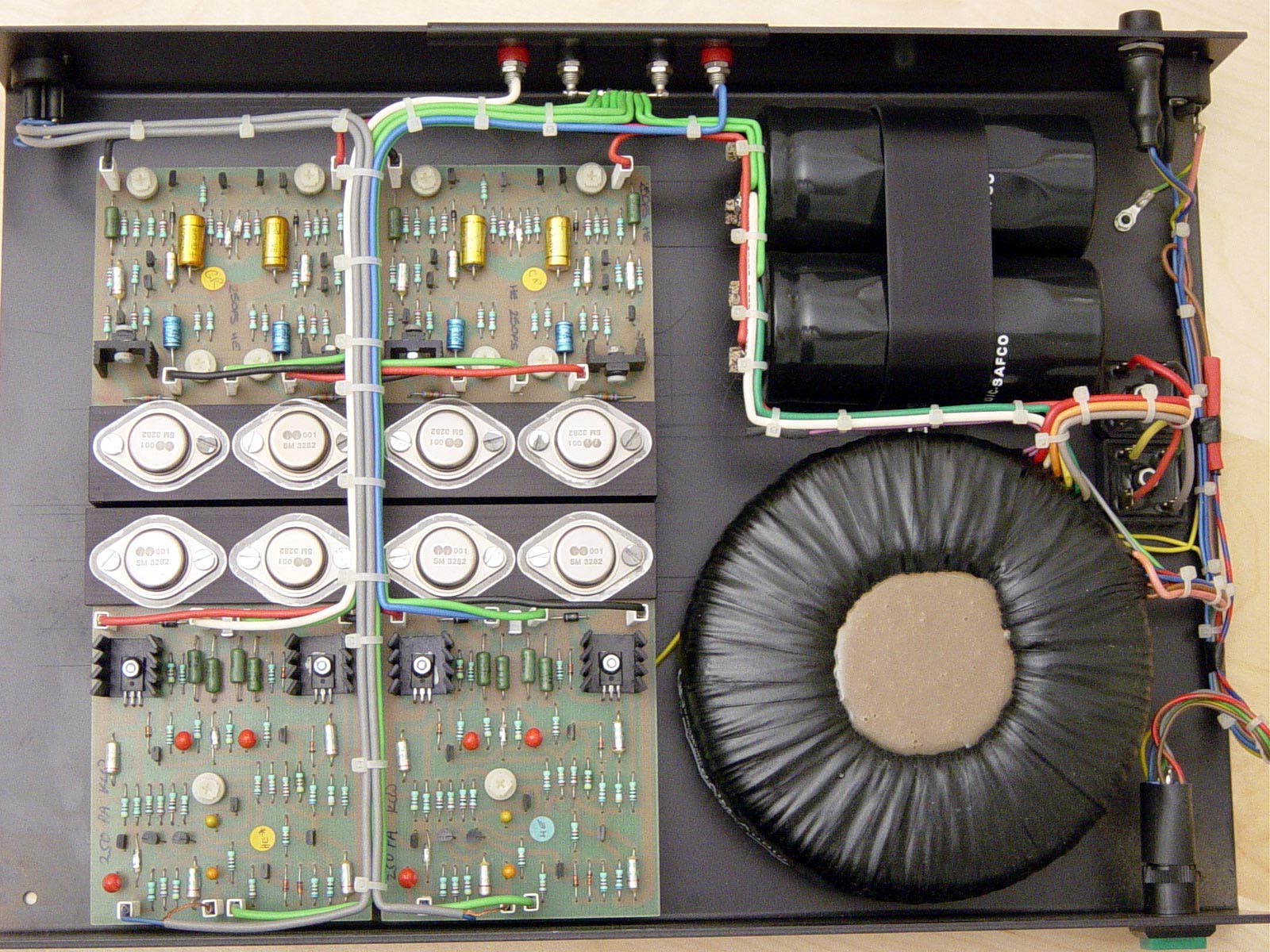
(Note that this is using Naim's earlier star ground on the speaker terminals, which I don't recommend. Better practice would be to put it between the two capacitors.)
The transistors/boards are mounted using aluminium C-section which is then bolted to the bottom of the case (with some thermal paste). You can make your own, or you can get nice pre-drilled, tapped and anodised ones from Les at Avondale Audio.
I think the transformers were 450VA; some argue they were 500VA. 2 x 41V secondaries. (A 41-0-41 centre-tapped will also work.)
Standard full-wave bridge rectification using block rectifiers bolted to the case. One smoothing cap per rail. Factory spec was Sic Safco FELSIC CO39 63V 15,000uF; most people are using 22,000uF Kendeils these days.
IEC, fuse and power switch. No soft-start or inrush-limitation. Not even an RFI suppression cap. (Julian Vereker even campaigned against the EU EMC directives as he thought they killed the music.)
Cheers,
Jeff.
Regulator PCBs are 121mm x 89mm
Note that the Naim temp compensation relies on a constant temp inside the case. So a heavy case without any ventilation will work best. That being said, a lot of folks have built clones ignoring this.
Here's a good picture of the insides/layout of a factory example:

(Note that this is using Naim's earlier star ground on the speaker terminals, which I don't recommend. Better practice would be to put it between the two capacitors.)
The transistors/boards are mounted using aluminium C-section which is then bolted to the bottom of the case (with some thermal paste). You can make your own, or you can get nice pre-drilled, tapped and anodised ones from Les at Avondale Audio.
I think the transformers were 450VA; some argue they were 500VA. 2 x 41V secondaries. (A 41-0-41 centre-tapped will also work.)
Standard full-wave bridge rectification using block rectifiers bolted to the case. One smoothing cap per rail. Factory spec was Sic Safco FELSIC CO39 63V 15,000uF; most people are using 22,000uF Kendeils these days.
IEC, fuse and power switch. No soft-start or inrush-limitation. Not even an RFI suppression cap. (Julian Vereker even campaigned against the EU EMC directives as he thought they killed the music.)
Cheers,
Jeff.
The original Naim's used automotive style connectors for the various board connections. I'm an old-car guy so I've had a lot of experience with them -- not all of it good.
The boards therefore have holes sized for soldering in the pins from MIL-DTL-26482 II connectors. These are the ones you want (male for the board and female for the wires):
https://www.mouser.ie/ProductDetail...EDKraRDbvZoA3/oLVJKdEGM8xjpnXvdTSHC%2BzLVXA==
https://www.mouser.ie/ProductDetail...c/EDKraRDbrg3O2NddvTaoIf0ASvjPQYkSh58AdxsdQ==
The boards therefore have holes sized for soldering in the pins from MIL-DTL-26482 II connectors. These are the ones you want (male for the board and female for the wires):
https://www.mouser.ie/ProductDetail...EDKraRDbvZoA3/oLVJKdEGM8xjpnXvdTSHC%2BzLVXA==
https://www.mouser.ie/ProductDetail...c/EDKraRDbrg3O2NddvTaoIf0ASvjPQYkSh58AdxsdQ==
- Home
- Group Buys
- NAP250 amp boards & regulator boards
